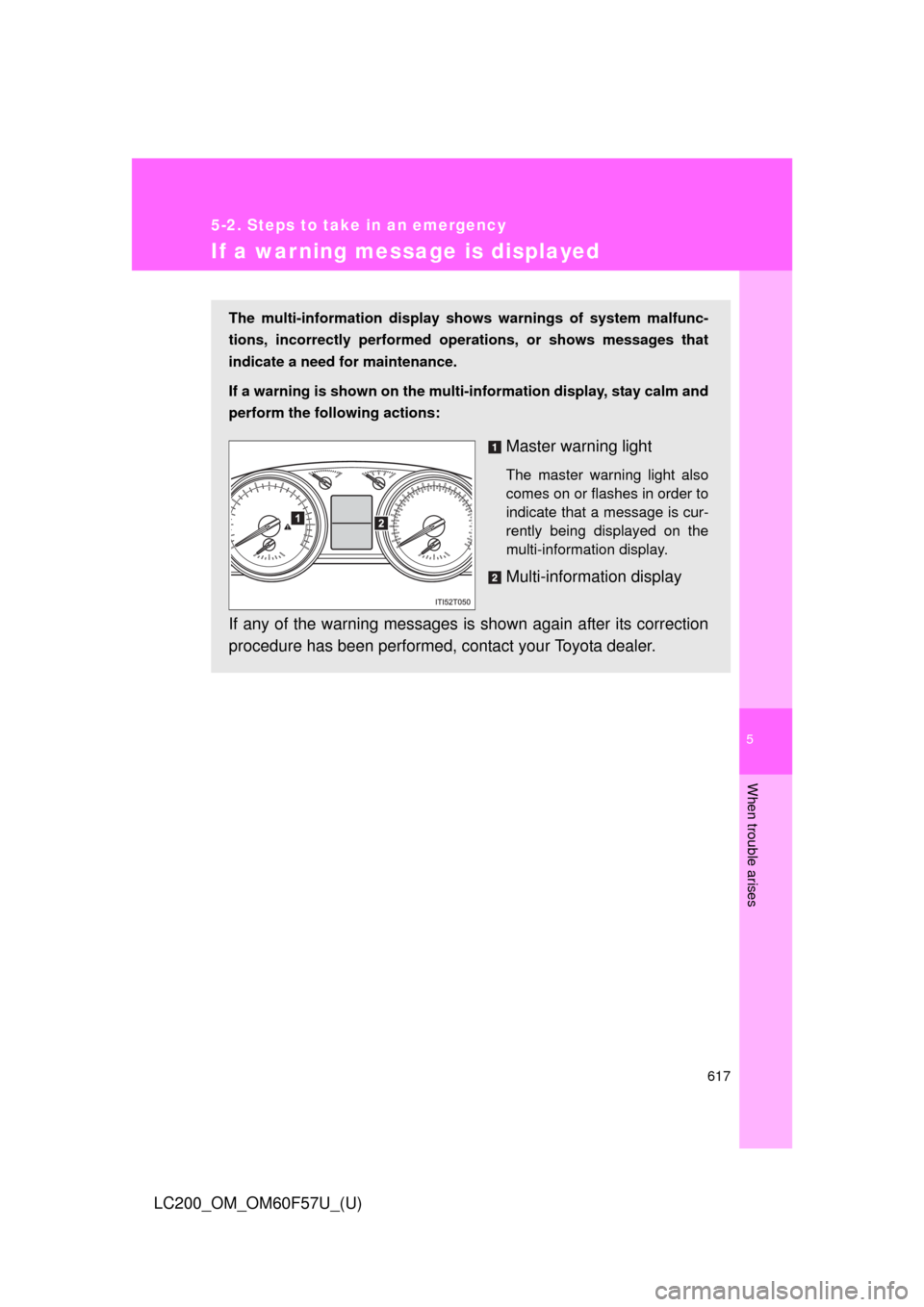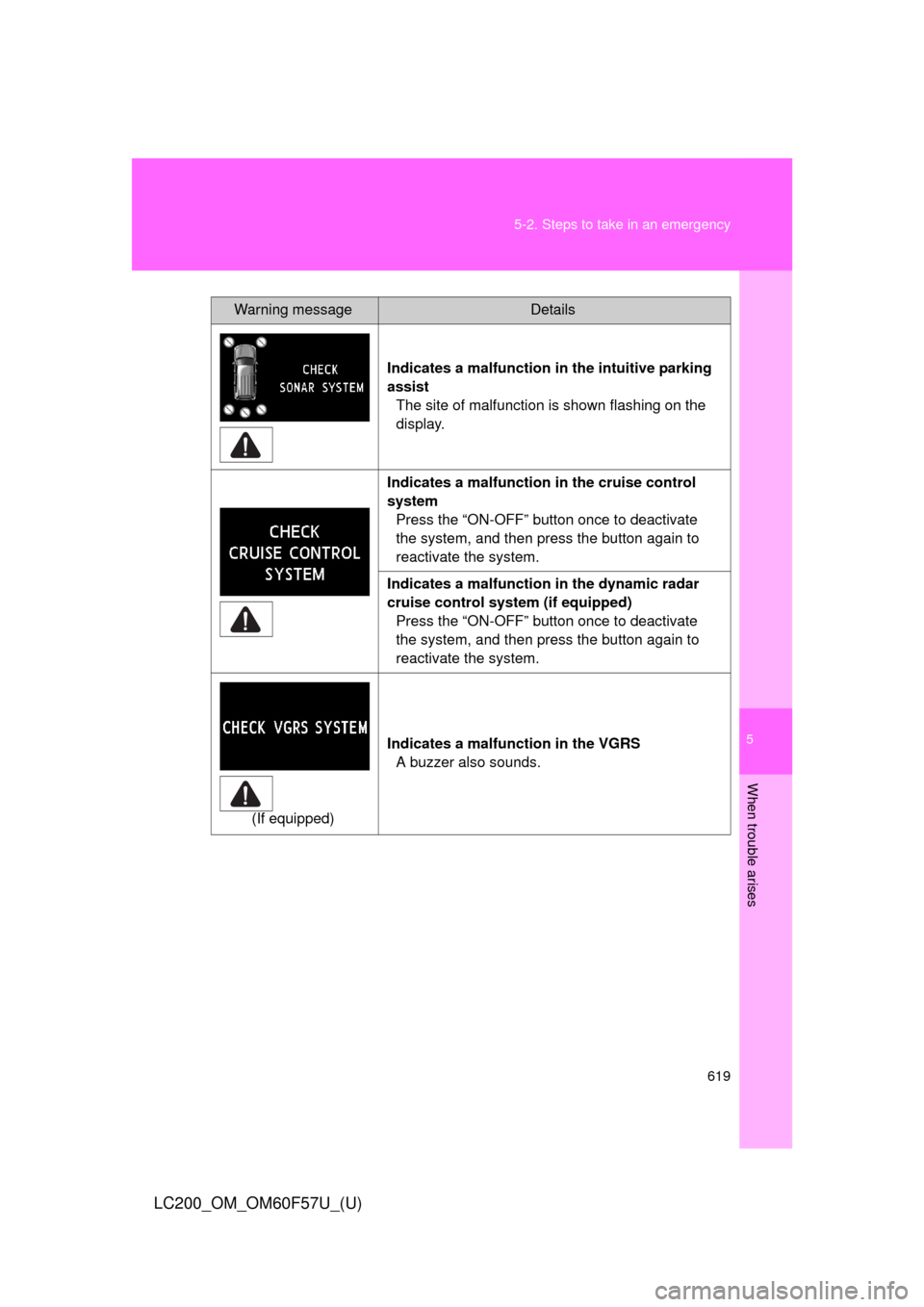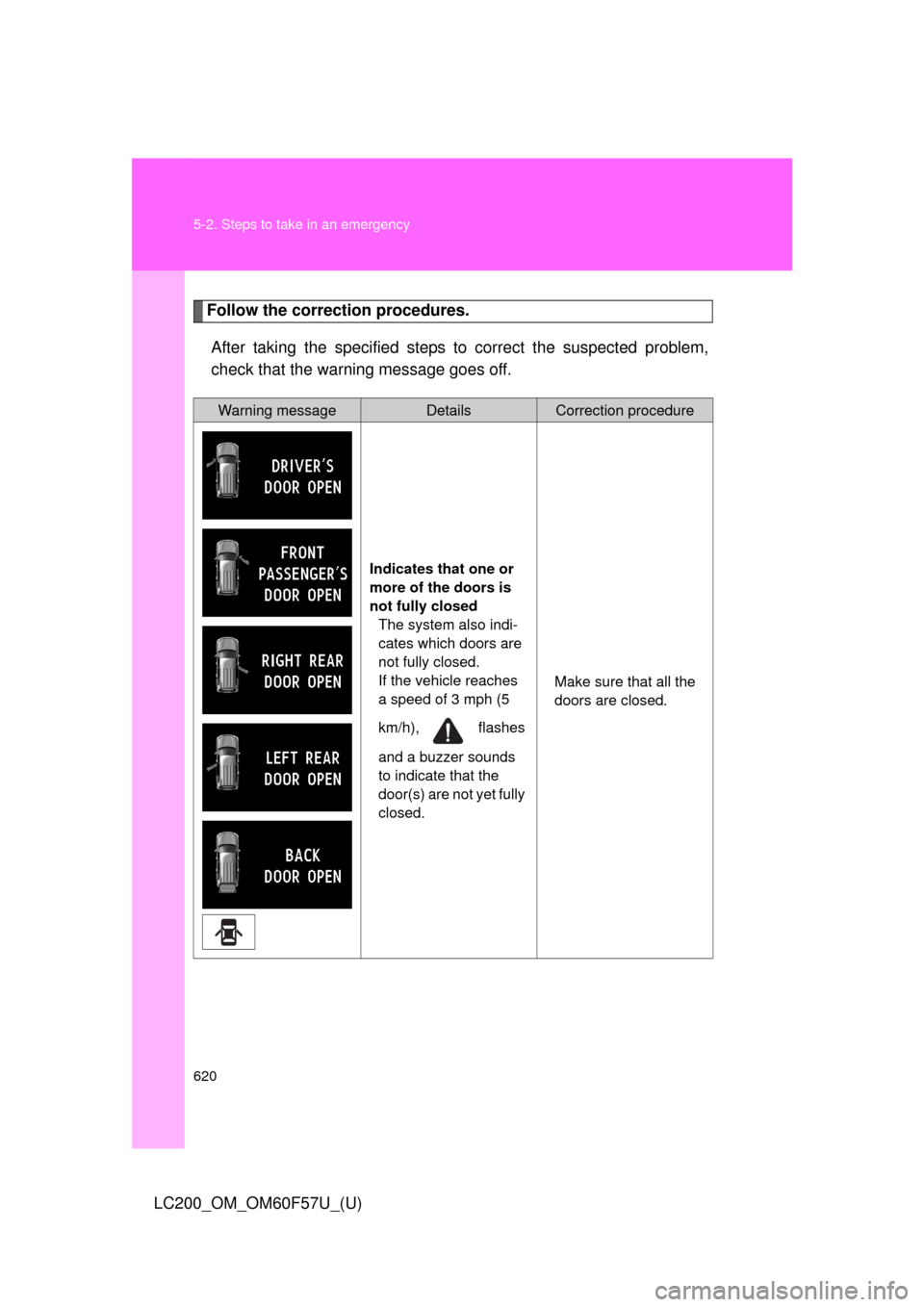TOYOTA LAND CRUISER 2013 J200 Owners Manual
Manufacturer: TOYOTA, Model Year: 2013, Model line: LAND CRUISER, Model: TOYOTA LAND CRUISER 2013 J200Pages: 720, PDF Size: 21.46 MB
Page 611 of 720

5
When trouble arises
611 5-2. Steps to take in an emergency
LC200_OM_OM60F57U_(U)
■If the malfunction indicator lamp comes on while driving
First check the following:
●Is the fuel empty?
If it is, fill the fuel tank immediately.
●Is the fuel tank cap loose?
If it is, tighten it securely.
The malfunction indicator lamp will go off after taking several driving trips. If
the malfunction indicator lamp does not go off even after several trips, con-
tact your Toyota dealer as soon as possible.
■If the low speed four-wheel drive indicator light or the center differen-
tial lock indicator light blinks
Take the specified steps. (P. 243)
If the brake system warning light or the malfunction indicator light also
comes on, or the low speed four-wheel drive indicator light or the center dif-
ferential lock indicator light continues to blink after taking the specified steps,
there may be a malfunction in the engine, the brake system or the four-
wheel drive system. In this case, you may not be able to transfer between
“H4” and “L4” modes, and the center differential lock may not be able to be
locked or unlocked. Have the vehicle inspected by your Toyota dealer imme-
diately.
■Front passenger detection sensor and passenger seat belt reminder
●If luggage is placed on the front passenger seat, the front passenger
detection sensor may cause the warning light to flash, even if a passen-
ger is not sitting in the seat.
●If a cushion is placed on the seat, the sensor may not detect a passen-
ger, and the warning light may not operate properly.
Page 612 of 720

612 5-2. Steps to take in an emergency
LC200_OM_OM60F57U_(U)
■SRS warning light
This warning light system monitors the following:
●The airbag sensor assembly
●Front impact sensors
●Side impact sensors (rear)
●Side impact sensors (front door)
●Safing sensor (rear)
●The driver’s seat belt buckle switch
●The driver’s seat position sensor
●Front passenger’s seat belt buckle switch
●The airbags
●The interconnecting wiring and power sources
●The front passenger occupant classification system
●“AIR BAG ON” and “AIR BAG OFF” indicator lights
●The seat belt pretensioners
●The “RSCA OFF” indicator light
■Changing the engine oil
Make sure to reset oil change system
■
When the tire pressure warning light comes on
Check the tire inflation pressure and adjust to the appropriate level.
Pushing the tire pressure warning reset switch does not turn off the tire
pressure warning light.
■The tire pressure warning light may turn on due to natural causes
The tire pressure warning light may turn on due to natural causes such
as natural air leaks or tire inflation pressure changes caused by temper-
ature. In this case, adjusting the tire inflation pressure will turn off the
warning light (after a few minutes).
Page 613 of 720

5
When trouble arises
613 5-2. Steps to take in an emergency
LC200_OM_OM60F57U_(U)
■When a tire is replaced with a spare tire
The spare tire is also equipped with the tire pressure warning valve and
transmitter. The tire pressure warning light will turn on if the tire inflation
pressure of the spare tire is low. If a tire goes flat, even though the flat
tire is replaced with the spare tire, the tire pressure warning light does
not turn off. Replace the spare tire with the repaired tire and adjust the
proper tire inflation pressure. The tire pressure warning light will turn off
after a few minutes.
■If the tire pressure warning system is inoperative
The tire pressure warning system will be disabled in the following condi-
tions:
(When the condition becomes normal, the system will work properly.)
●If tires not equipped with tire pressure warning valves and transmit-
ters are used.
●If the ID code on the tire pressure warning valves and transmitters is
not registered in the tire pressure warning computer.
●If the tire inflation pressure is 73 psi (500 kPa, 5.1 kgf/cm2 or bar) or
higher.
The tire pressure warning system may be disabled in the following condi-
tions:
(When the condition becomes normal, the system will work properly.)
●If electronic devices or facilities using similar radio wave frequencies
are nearby.
●If a radio set at similar frequencies is in use in the vehicle.
●If a window tint that affects the radio wave signals is installed.
●If there is a lot of snow or ice on the vehicle, in particular around the
wheels or wheel housings.
●If non-genuine Toyota wheels are used. (Even if you use Toyota
wheels, the tire pressure warning system may not work properly with
some types of tires.)
●If tire chains are used.
●If the spare tire is in a location subject to poor radio wave signal
reception.
●If a large metallic object which can interfere with signal reception is
put in the luggage compartment.
Page 614 of 720

614 5-2. Steps to take in an emergency
LC200_OM_OM60F57U_(U)
■If the tire pressure warning light frequently comes on after blinking
for 1 minute
If the tire pressure warning light frequently comes on after blinking for 1
minute when the “ENGINE START STOP” switch is turned to IGNITION
ON mode, have it checked by Toyota dealer.
CAUTION
■If the tire pressure warning light comes on
Be sure to observe the following precautions. Failure to do so could
cause loss of vehicle control and result in death or serious injury.
●Stop your vehicle in a safe place as soon as possible. Adjust the tire
inflation pressure immediately.
●If the tire pressure warning light comes on even after tire inflation pres-
sure adjustment, it is probable that you have a flat tire. Check the tires.
If the tire is flat, change to the spare tire and have the flat tire repaired
by the nearest Toyota dealer.
●Avoid abrupt maneuvering and braking. If the vehicle tires deteriorate,
you could lose control of the steering wheel or the brakes.
■If a blowout or sudden air leakage should occur
The tire pressure warning system may not activate immediately.
Page 615 of 720

5
When trouble arises
615 5-2. Steps to take in an emergency
LC200_OM_OM60F57U_(U)
CAUTION
■Maintenance of the tires
Each tire, including the spare (if provided), should be checked monthly
when cold and inflated to the inflation pressure recommended by the
vehicle manufacturer on the vehicle placard or tire inflation pressure
label (tire and load information label). (If your vehicle has tires of a differ-
ent size than the size indicated on the vehicle placard or tire inflation
pressure label [tire and load information label], you should determine the
proper tire inflation pressure for those tires.)
As an added safety feature, your vehicle has been equipped with a tire
pressure monitoring system (TPMS-tire pressure warning system) that
illuminates a low tire pressure telltale (tire pressure warning light) when
one or more of your tires is significantly under-inflated. Accordingly,
when the low tire pressure telltale (tire pressure warning light) illumi-
nates, you should stop and check your tires as soon as possible, and
inflate them to the proper pressure. Driving on a significantly under-
inflated tire causes the tire to overheat and can lead to tire failure.
Under-inflation also reduces fuel efficiency and tire tread life, and may
affect the vehicle’s handling and stopping ability.
Please note that the TPMS (tire pressure warning system) is not a sub-
stitute for proper tire maintenance, and it is the driver’s responsibility to
maintain correct tire pressure, even if under-inflation has not reached the
level to trigger illumination of the TPMS low tire pressure telltale (tire
pressure warning light).
Page 616 of 720

616 5-2. Steps to take in an emergency
LC200_OM_OM60F57U_(U)
CAUTION
Your vehicle has also been equipped with a TPMS (tire pressure warning
system) malfunction indicator to indicate when the system is not operat-
ing properly. The TPMS (tire pressure warning system) malfunction indi-
cator is combined with the low tire pressure telltale (tire pressure
warning light). When the system detects a malfunction, the telltale will
flash for approximately one minute and then remain continuously illumi-
nated. This sequence will continue upon subsequent vehicle start-ups as
long as the malfunction exists. When the malfunction indicator is illumi-
nated, the system may not be able to detect or signal low tire pressure
as intended.
TPMS (tire pressure warning system) malfunctions may occur for a vari-
ety of reasons, including the installation of replacement or alternate tires
or wheels on the vehicle that prevent the TPMS (tire pressure warning
system) from functioning properly. Always check the TPMS (tire pres-
sure warning system) malfunction telltale after replacing one or more
tires or wheels on your vehicle to ensure that the replacement or alter-
nate tires and wheels allow the TPMS (tire pressure warning system) to
continue to function properly.
NOTICE
■Precaution when installing a different tire
A tire of a different specification or maker may cause the tire pressure
warning system to not operate properly.
Page 617 of 720

5
When trouble arises
617
5-2. Steps to take in an emergency
LC200_OM_OM60F57U_(U)
If a warning message is displayed
The multi-information display shows warnings of system malfunc-
tions, incorrectly performed operations, or shows messages that
indicate a need for maintenance.
If a warning is shown on the multi-information display, stay calm and
perform the following actions:
Master warning light
The master warning light also
comes on or flashes in order to
indicate that a message is cur-
rently being displayed on the
multi-information display.
Multi-information display
If any of the warning messages is shown again after its correction
procedure has been performed, contact your Toyota dealer.
Page 618 of 720

618 5-2. Steps to take in an emergency
LC200_OM_OM60F57U_(U)
Have the vehicle inspected immediately.
Failure to investigate the cause of the following warnings may lead to
the system operating abnormally and possibly cause an accident.
Have the vehicle inspected by your Toyota dealer immediately.
Warning messageDetails
Indicates a malfunction in the automatic
transmission system
A buzzer also sounds.
Indicates a malfunction in the steering lock
system
A buzzer also sounds.
(If equipped)Indicates a malfunction in the pre-collision sys-
tem
A buzzer also sounds.
Page 619 of 720

5
When trouble arises
619 5-2. Steps to take in an emergency
LC200_OM_OM60F57U_(U)
Indicates a malfunction in the intuitive parking
assist
The site of malfunction is shown flashing on the
display.
Indicates a malfunction in the cruise control
system
Press the “ON-OFF” button once to deactivate
the system, and then press the button again to
reactivate the system.
Indicates a malfunction in the dynamic radar
cruise control system (if equipped)
Press the “ON-OFF” button once to deactivate
the system, and then press the button again to
reactivate the system.
(If equipped)Indicates a malfunction in the VGRS
A buzzer also sounds.
Warning messageDetails
Page 620 of 720

620 5-2. Steps to take in an emergency
LC200_OM_OM60F57U_(U)
Follow the correction procedures.
After taking the specified steps to correct the suspected problem,
check that the warning message goes off.
Warning messageDetailsCorrection procedure
Indicates that one or
more of the doors is
not fully closed
The system also indi-
cates which doors are
not fully closed.
If the vehicle reaches
a speed of 3 mph (5
km/h), flashes
and a buzzer sounds
to indicate that the
door(s) are not yet fully
closed.Make sure that all the
doors are closed.